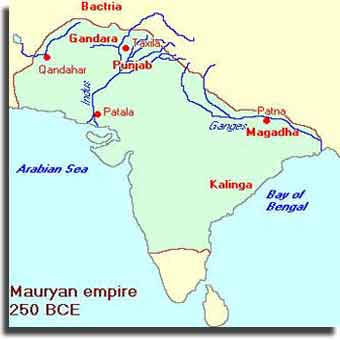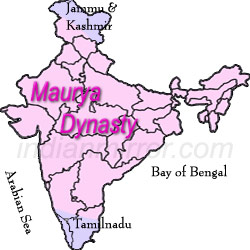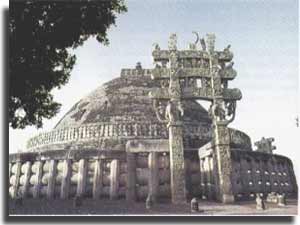History :
King Alexander the Great from Macedonia invaded the valley of the river Kabul. He conquered Taxila, defeated the Indian king Porus at the river Hydaspes and reached the eastern border of the Punjab. Alexander wanted to continue to the kingdom of Magadha in the Lower Ganges valley, but his soldiers refused to go any further and he was forced to go to south. Many Indians now resisted the invaders. The Great king's conquests had been spectacular, but he had not conquered India. Alexander had died in 323. A young man in Taxila named Chandragupta Maurya had seen the Macedonian army and believing that anything a European could do an Indian could do better- decided to train an army on a similar footing. In 321, he seized the throne of Magadha. Thus the Mauryan Empire was born.
Mauryans were the first Indian dynasty in the fourth-third centuries BCE, which unified the subcontinent for the first time and contributed to the spread of Buddhism. Chandragupta Maurya the great emperor with his single entity united most of the parts of India. Mauryan Period in India enjoyed an era of social harmony, religious transformation, and expansion of the sciences and of knowledge. This period was known as the "Golden Age of India." During this Period Hinduism and Buddhism spread to much of south-east Asia.
Chandragupta Maurya (322-298BC)
Chandragupta belonged to the caste of warriors (Kshatriya) and was a pupil of a famous Brahman teacher, Kautilya. His coup was more than just the take-over of a kingdom; it was a religious counter-revolution, because the lawful kings of Magadha, the Nanda dynasty did not belonged to the warrior caste. They had been mere commoners, said to be descendants of a barber. When Chandragupta claimed the throne, their heresy came to an end and orthodox Brahmanism was vindicated. Chandragupta united the Indus and Ganges valley - a formidable empire. The empire included secret service, there were inspectors, there was a large army, and the capital at Patna became a beautiful city.
Chandragupta was advised by Kautilya who wrote a guide to statecraft which is known as Arthasastra. The Arthashastra describes about the principles of governance and lays down rules of administration. It also emphasises about the details of the role of the king, his duties, rate of taxation, use of espionage, and laws for governing the society. The Indica of Megasthenes, on the other hand, gives a vivid description of the Mauryan society under the rule of Chandragupta. Megasthenes showed the glory of the Mauryan capital of Pataliputra. Megasthenes also talked of the lifestyle in the cities and villages and the prosperity of the Mauryan cities. A Greek visitor, Megasthenes, gave a very strange description of the caste system (accepting seven instead of the usual four classes of people), and he describes an attempted reform. This is certainly not impossible as Chandragupta turned out to be not deeply attached to orthodox Brahmanism. He died as an ascetic, having fasted to death.
Place |
Punjab, Patna, Odissi, Mysore |
Period |
322 BC - 185 BC |
Language |
Old Indic (Sanskrit, Prakrits) |
Rulers |
Chandragupta Maurya, Bindusara, Ashoka the great, Dasaratha, Satadhanvan, Brihadratha |
Religion |
Brahmanism, Buddhism, Jainism |

indusara (296-273BC)
Chandragupta's son Bindusara extended the kingdom of Mauryas over almost the entire sub-continent. The military force of Mauryan Empire was the most powerful in ancient India. Bindusara's reign lasted a quarter of a century, until 272. Of the three great Mauryan emperors, he is the least known. For example, he is mentioned as the man who conquered "the country between the two seas" (i.e., the Bay of Bengal and the Arabian Sea), which suggests that he conquered central India, but the same deeds are ascribed to his son Ashoka. He extended the Mauryan Empire in south Indian peninsula as far as Mysore. He defeated and annexed 16 small kingdoms, thus extending his empire from sea to sea. The regions that were left out on the Indian subcontinent were only that of Kalinga (Odissi) and the kingdoms to the extreme south of the Indian peninsula. As the southern kingdoms were friendly, he did not annex them, but the Kingdom of Kalinga was a problem for Mauryan Empire. Administration under Bindusara functioned smoothly. During Bindusara's reign, Mauryan Empire had good relation with Greeks, Syrians, and Egyptians.
Ashoka (273bc – 232BC)


Emperor Ashoka believed in high ideals, according to him were that people to be virtuous, and peace loving. This he called Dhamma (which is a Prakrit form of the Sanskrit word Dharma). Ashoka's rock edicts and pillar inscriptions propagated the true essence of Dhamma. He asked the different religious groups (Brahmins, Buddhist and Jain) to live in peace. His lofty ideals also included shunning violence and war, stopping animal sacrifice, respect for elders, respect of slaves by their masters, vegetarianism, etc. Above all, Ashoka wanted peace in his empire. He had a friendly relation with his neighbors and sent and received envoys to/from them. Ashoka sent his son Mahendra to Sri Lanka to preach Buddhism there and also propagated Buddhism to Chola and Pandya kingdoms, which were at the extreme southern part of the Indian peninsula. The Mauryan Empire did not last long after the death of Ashoka and ended in 185 BC.


